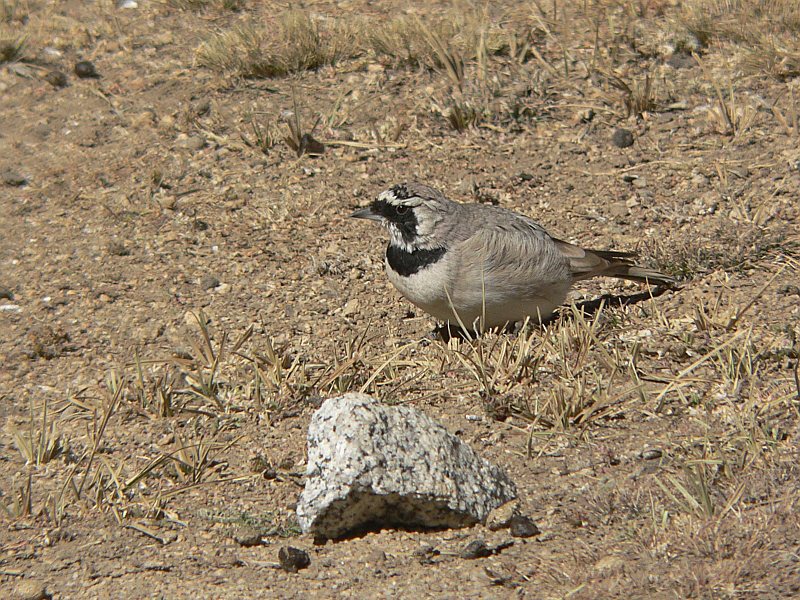| Kingdom: Animalia Phylum: Chordata Class: Aves (Birds) Order: Passeriformes Family: Alaudidae |
 Horned Lark - photograph © Rajiv Lather
Horned Lark (Eremophila alpestris) is a local resident in higher altitudes of Himalayas. Larks are ground-dwelling birds with bland, yet cryptic plumage. Highly terrestrial, these birds shuffle along the ground rather than hop. Their slightly undulating flight is characterized by low, flowing swoops over open country. When flushed, they return to the ground, rarely alighting on trees or shrubs. Widespread and gregarious, Horned Larks form flocks in wide, open fields, tundra, grasslands, shores or gravel ridges. Size: 18 cm Identification: These slender birds are long-winged with short, stout bills and squared-off tails. Their most distinctive traits are their "horns," or the black feathers projecting upward from either side of their heads. The colorful head pattern of adults also includes a yellowish face and throat and diagonal, black cheek-stripes underneath the eyes. Streaked in gray above, the buffy flanks and white underparts are offset by the striking, black bib. Although the outer tail is edged in white, the black tail feathers are most conspicuous during flight. Although all plumages display the characteristic "horns," face mask and breast band, these traits are less prominent in the duller females and juveniles. All sexes and ages cryptically blend into their surroundings and are difficult to locate on the ground. Calls: High and weak, the repeated notes of Horned Lark's song are given during high flight, "reeek, trik, treet, tritilititi, tree." Other variations include a high and soft "see-tu" or "see-titi." In winter, their call is composed of faint, tinkling notes. Nests: Horned Larks nest in shallow, ground depressions at the bases of bushes or grass tufts. The female selects the nest site and lines the plate-shaped nest with roots, grasses, plant down, and hair. Often, pebbles or dirt clods are placed at the rim of the most exposed side. A clutch consists of 2-5, 22 mm, gray to greenish eggs, heavily speckled with brown. The female alone incubates the clutch for 11-12 days and the young birds fledge in another 9-12 days. If the mother detects a threat, she will perform a fluttering distraction display to lure danger away from the nest. Both parents rear the fledglings. Juvenile birds aggregate in large flocks at the end of the breeding season. Food: The Horned Lark eats primarily seeds of grasses and forbs as well as insects, although it is also known to consume spiders and snails. These larks forage by gleaning food as they walk along the ground in their shuffling gate. In winter, these birds feed in freshly manured fields in agricultural areas. |
